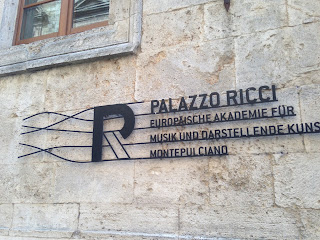 When we arrived in Montepulciano, I was instantly
captivated. We wandered through the town inside of the old fortress, admiring
all the enotecas and street artists. Everything was beautiful and had a story.
The winery we visited was no exception. We arrived in the Piazza Grande and
tried to take in the church, the well (Molly and I acted like five-year-olds
and yelled down it), and the piazza at large. A few steps further and we were
at the Palazzo Ricci. We went into the courtyard, admiring the 15th
century palace. We knew that we were supposed to have a wine tour, so we
attempted to open multiple doors from the courtyard in our effort to find the
wine room. Josie suddenly saw a sign that pointed down a staircase to the
Cantina de’ Ricci, so we started going down the staircase. We thought it would
be a quick descent, but the impressive staircase kept going and going, and we
could feel the temperature sinking the lower we descended. Suddenly we found
ourselves in a dark cellar, but cellar feels like the wrong word. The ceilings
were grand, and the large casks of wine were situated under arches. We didn’t
see a tour guide, so we all wandered the different rooms of the cellar, which
almost seemed like caves. Then we heard the voice of an Italian man, welcoming
us to the Cantina de’ Ricci, one of the most beautiful wine cellars in the
world.
When we arrived in Montepulciano, I was instantly
captivated. We wandered through the town inside of the old fortress, admiring
all the enotecas and street artists. Everything was beautiful and had a story.
The winery we visited was no exception. We arrived in the Piazza Grande and
tried to take in the church, the well (Molly and I acted like five-year-olds
and yelled down it), and the piazza at large. A few steps further and we were
at the Palazzo Ricci. We went into the courtyard, admiring the 15th
century palace. We knew that we were supposed to have a wine tour, so we
attempted to open multiple doors from the courtyard in our effort to find the
wine room. Josie suddenly saw a sign that pointed down a staircase to the
Cantina de’ Ricci, so we started going down the staircase. We thought it would
be a quick descent, but the impressive staircase kept going and going, and we
could feel the temperature sinking the lower we descended. Suddenly we found
ourselves in a dark cellar, but cellar feels like the wrong word. The ceilings
were grand, and the large casks of wine were situated under arches. We didn’t
see a tour guide, so we all wandered the different rooms of the cellar, which
almost seemed like caves. Then we heard the voice of an Italian man, welcoming
us to the Cantina de’ Ricci, one of the most beautiful wine cellars in the
world. |
| The casks under the cathedral arches |
Our guide was dressed in jeans and a puffy vest, clearly
aware of the cold temperature around him. He told us that we were 25 meters
underneath the courtyard in what was originally commissioned to be a cathedral.
That explained the grand arches and columns of the cantina. However, the church
was never consecrated, so it sat idle until the Ricci family decided to convert
it into a wine cellar, due to the
consistent cool temperature and the available
room. The Ricci family ran the winery for generations until the last daughter chose to not marry and have children to instead devote her life to the poor. Now one of the close friends of the Ricci family runs the winery. Our guide pointed out the giant casks and explained that, while other
wineries prefer to only keep their oak casks for three years, the Ricci winery
preferred to keep their casks for nearly fifty years. They use a Slavonian (not
Slovenian, as is often confused) oak, and each year they ‘shave’ the innermost
layer of the cask to bring a fresh layer to the forefront. However, they don’t
want an overwhelming oak flavor, hence why they prefer older casks. He
explained how hectoliters work, and showed us the different barriques that hold
volumes varying from 10 hectoliters to 5 hectoliters.  |
| Our wine tasting set-up |
After our tour of the cellar, our guide took us upstairs for
a wine tasting. Each setting had three different wines (one from a concrete
cask, the Vino Nobile, and a Super Tuscan) with varying meats and cheeses. The
whole experience was so interesting, and it was honestly my favorite winery
that we visited. Hearing the story behind each place creates more of a
connection, and the de’ Ricci winery story was captivating and interesting. I
loved every moment of it.
-Courtney Catalani
No comments:
Post a Comment
Your comment will appear if approved. Thank you.